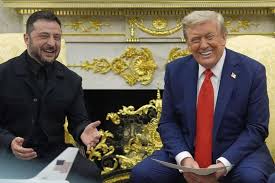
Trump proposes Putin–Zelenskyy summit to push for Ukraine war peace talks

 :
| Updated On: 19-Aug-2025 @ 12:04 pm
:
| Updated On: 19-Aug-2025 @ 12:04 pmSHARE
Former US President Donald Trump has announced plans to hold a face-to-face summit between Russian President Vladimir Putin and Ukrainian President Volodymyr Zelenskyy as part of his effort to end Moscow’s war in Ukraine. The proposal was revealed during high-level talks at the White House on Monday, where Trump hosted Zelenskyy along with European leaders, including French President Emmanuel Macron and UK Prime Minister Keir Starmer. The discussions aimed at seeking ways to resolve the conflict, which began in February 2022 with Russia’s full-scale invasion.
Trump said that he had already spoken to Putin by phone and begun preparations for a summit. His plan involves first a bilateral meeting between Putin and Zelenskyy, followed by a trilateral discussion with himself included. He described this as “a very good, early step” toward ending a war now in its fourth year. Senior officials including Vice President JD Vance, Secretary of State Marco Rubio, and Special Envoy Steve Witkoff have been tasked with coordinating with Russia and Ukraine on the proposal.
German Chancellor Friedrich Merz and NATO Secretary-General Mark Rutte later confirmed that Putin had agreed in principle to a bilateral meeting, although no date or venue was specified. Zelenskyy, calling his talks with Trump a “very good conversation,” expressed readiness to meet Putin directly. Moscow has not formally confirmed, but Russia’s TASS news agency quoted a presidential aide as saying Putin and Trump both supported continuing direct talks between delegations. If realized, this summit would mark the first direct meeting between Putin and Zelenskyy since the invasion.
A central topic at the White House talks was security guarantees for Ukraine. However, specifics remain vague. Trump suggested that European countries would serve as the “first line of defence,” with the US providing coordination and substantial support. Zelenskyy said that guarantees would be “unpacked” and finalized within 7–10 days. NATO’s Article 5, which treats an attack on one member as an attack on all, served as the backdrop for discussions on collective security. Rutte described US involvement in guaranteeing Ukraine’s security as a “breakthrough,” though he clarified that troop deployment had not been discussed.
Experts, however, warned of significant challenges. Konstantin Sonin, a Russian exile and critic of Putin, argued that genuine security guarantees would require European troops on the ground, which Putin is unlikely to accept. He noted that Russia has repeatedly violated treaties recognizing Ukraine’s sovereignty, including during the 2014 annexation of Crimea. He emphasized that the issue is less about treaty language and more about enforcement and deterrence.
Another unresolved issue is territorial concessions. Trump signaled that Crimea would not be returned to Ukraine and hinted at “swapping” or “changes in land” as part of any deal. Russia currently controls about one-fifth of Ukraine, while Ukraine holds no Russian territory despite briefly advancing into Russia’s Kursk region. Secretary of State Marco Rubio acknowledged that both sides would need to make concessions, including over borders, if peace is to be achieved. Zelenskyy, however, maintained that questions of land and sovereignty would be settled only between himself and Putin.
Analysts such as Yurii Poita from Kyiv described the talks as cautiously positive, noting that Trump’s willingness to work on a framework for security guarantees marks progress. Still, he stressed that unresolved issues—particularly sanctions pressure on Russia and the credibility of security guarantees—could determine whether peace is sustainable. Without firm commitments and enforcement, experts warn that any temporary peace risks collapsing into renewed conflict.